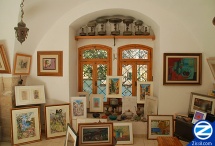Moshe Castel
Moshe Castel, a native of Jerusalem, was one of Israel’s best known abstract artists. He was the founder of the ‘New Horizons’ group of artists, and his murals decorate important Israeli public buildings. His work can be seen online, in galleries around the world and at the Moshe Castel Museum in Ma’aleh Adumim.
Contents |
[edit] Background
Moshe Elazar Castel was born in 1909 in Jerusalem to a religious Sephardi family whose roots in Israel go back over 400 years to the Spanish expulsion. His father, Rabbi Yehuda Castel' worked as a scribe and designed creative Torah scroll covers and curtains for synagogue Holy Arks.
The young Castel wanted to study art and went to the Bezelel Art School in 1921 where he learned for three years. Moshe proved to be a talented artist and his work was first displayed at an Israeli Artists’ group exhibition at the Tower of David in Jerusalem.
[edit] Paris
Moshe Castel then furthered his art education in Paris and as part of his training spent time copying the great masters in the Louvre. During the day he worked to support himself and at night painted in the studio he shared with the sculptor Giacometti. When Castel held his first solo exhibition in May 1927, Jabotinsky, who admired the young painter, wrote an introduction in the catalogue. As Castel’s reputation increased he was taken on by the Galerie Jacques, who made an agreement to buy all his paintings for three years. Moshe Castel continued to exhibit in Paris as well as London, Warsaw and Haifa. By 1936 Castel was in a position to organize a show in Tel Aviv for other artists, like Chagall, also working in Paris.
[edit] Israel
With the outbreak of WW2, Moshe Castel returned to Israel and moved to Safed (Tzfat) joining other artists already working there. Despite the war, Castel was able still able to exhibit, having a one-man show in Tel Aviv in 1942, and another in 1946. In 1948, due to artistic differences, Castel led a break-away from the ‘Israeli Artists’ Union’ and formed his own group called ‘New Horizons’. This group had more of universal outlook towards art, and looked towards the abstract European artists like Picasso for inspiration. Moshe Castel continued to live and work in Israel, but from 1959 onwards he spent several months a year working in his Paris studio. He exhibited frequently, both in solo shows and in joint exhibitions internationally representing the best of Israeli art.
[edit] Style
Castel’s connection to the land was very strong and on his return to Israel, Castel started to use basalt, a black indigenous rock, in his paintings. Using strong colors like red, green and black in his abstract work, he would add basalt in relief to give the appearance of an ancient script. He painted several murals for public spaces using this method. Moshe Castel felt deeply about his native city and many of his most famous works reflect his love for Jerusalem and can be found there. His ‘Song of Praise to Jerusalem’ decorates the Israeli Parliament (the Knesset), while ‘Wall of Praise to Jerusalem’ is one of two of his works in the Presidential Mansion. The National Convention Centre has a glass mural of his, and he also created pieces for the Weitzman Institute in Rechovot. Castel’s work can also be found in other prestigious locations in Israel like the Diamond Center in Ramat Gan. He is well represented in galleries abroad, including the Museum of Modern Art in New York and the Tate Gallery in London.
[edit] Legacy
During his lifetime Moshe Castel was honored with several retrospectives, including one in 1984 held at the Knesset. A book of his etchings and lithographs was published in 1988. In 2010, on what would’ve been his hundredth birthday the Moshe Castel Museum was opened in Ma’aleh Adumim.
